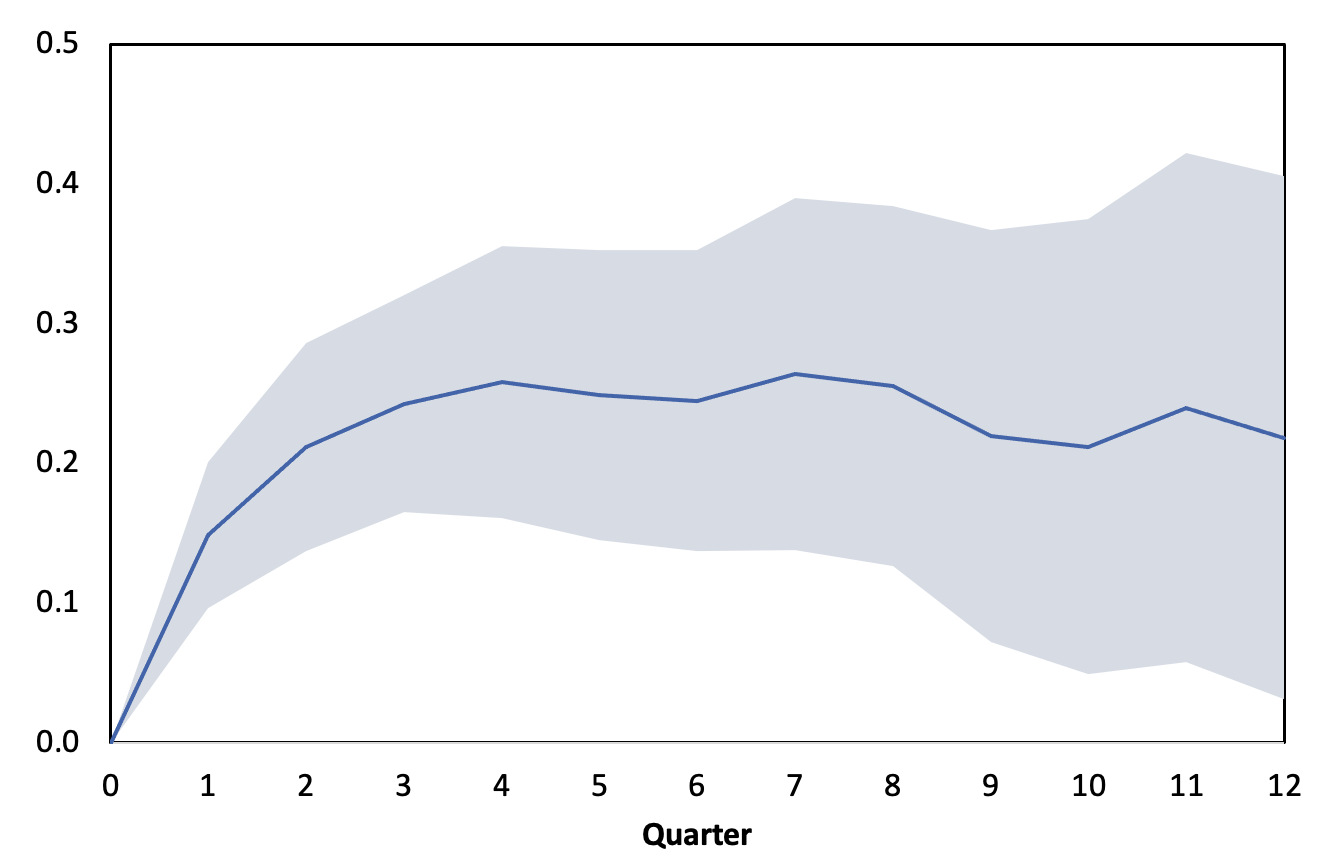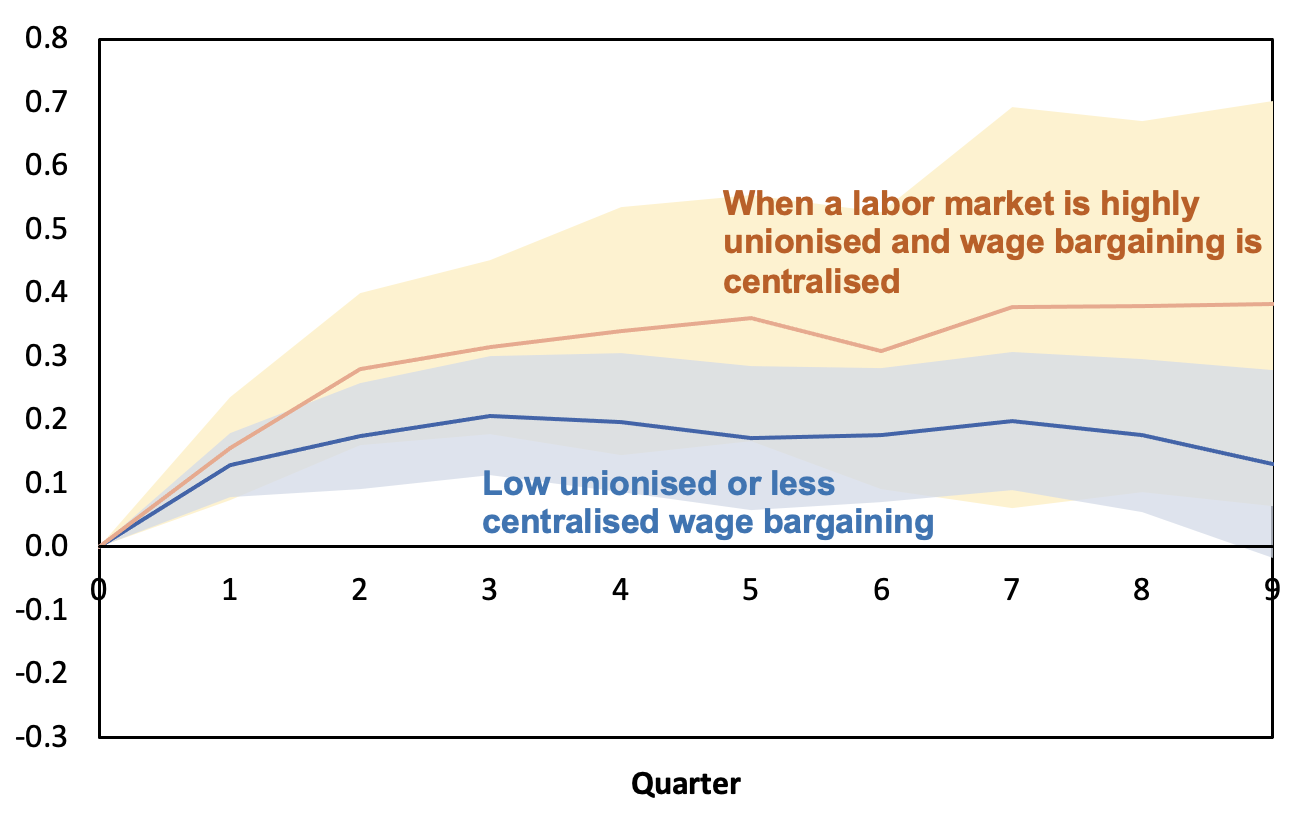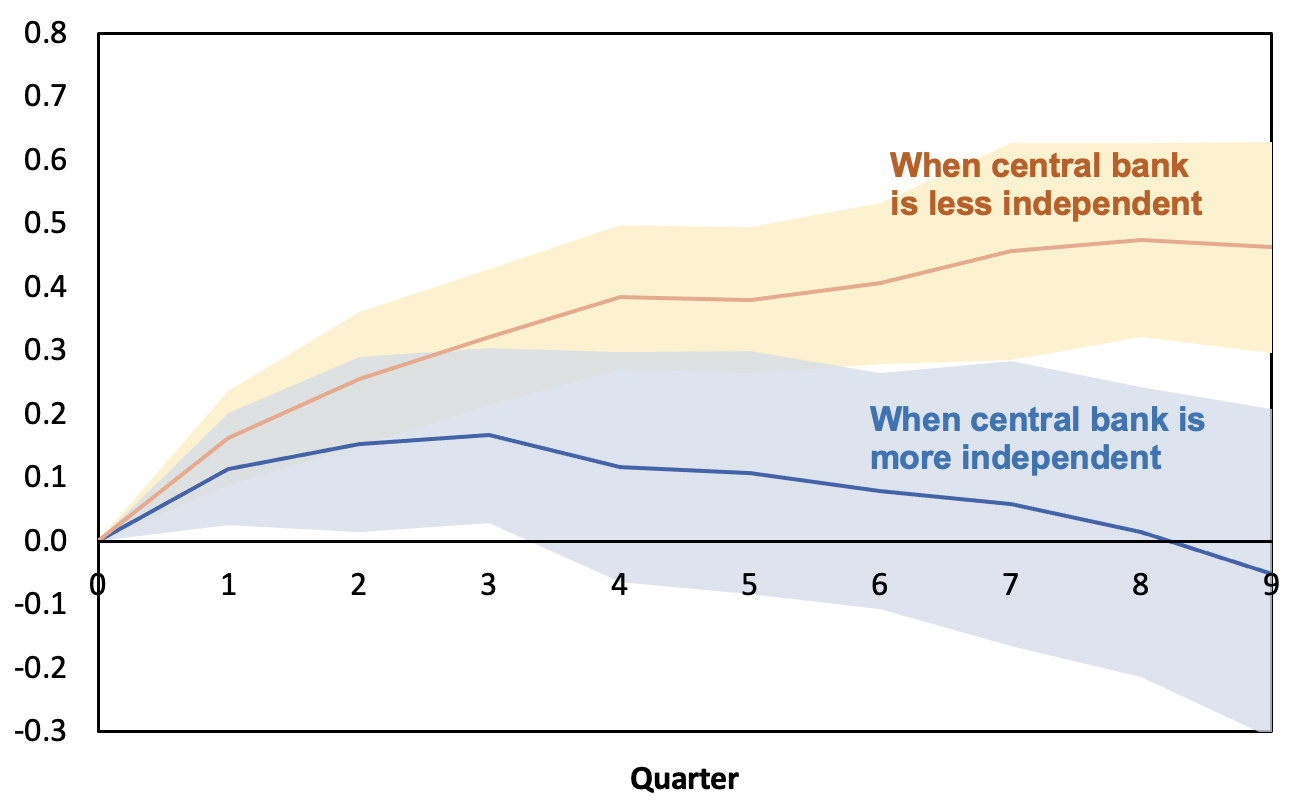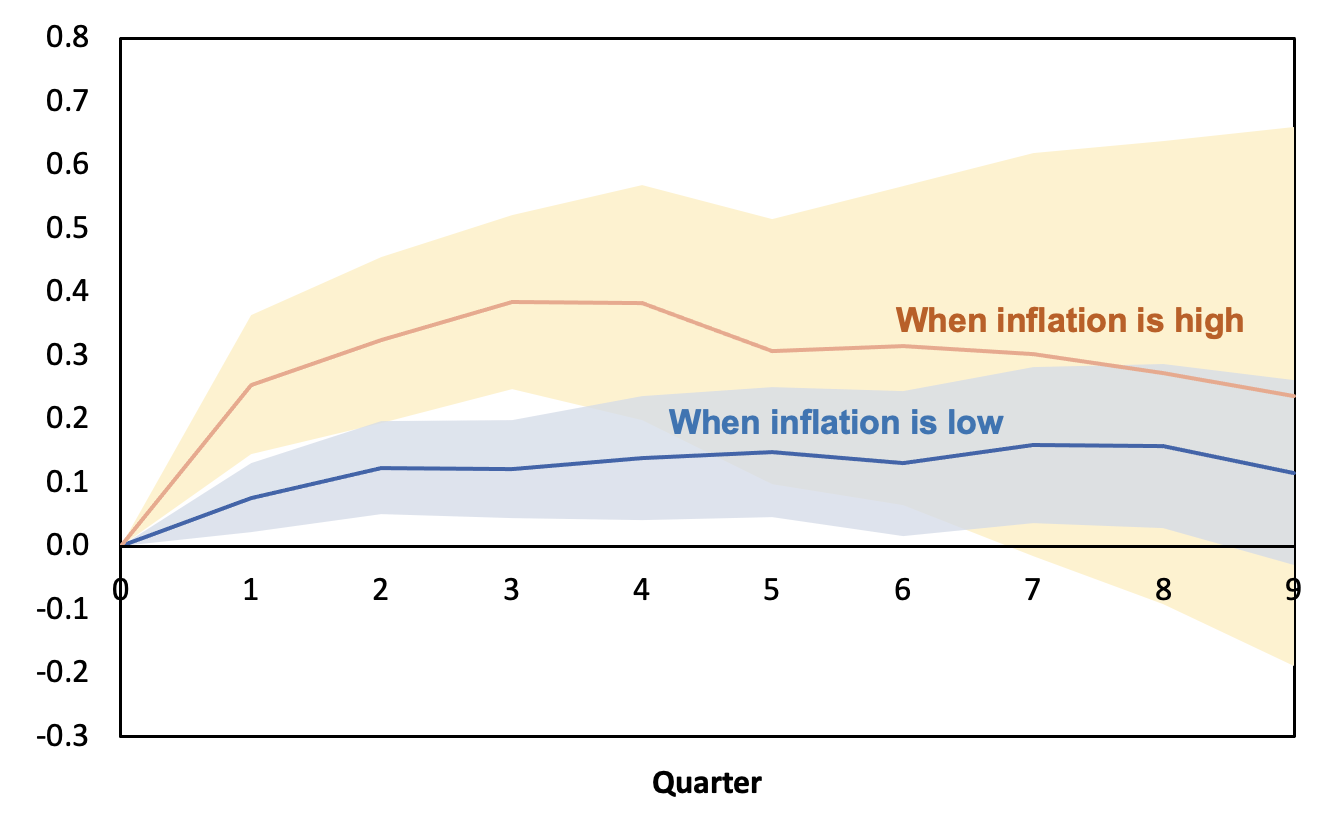High inflation has returned to media headlines and the centre stage of policy debate. In fact, inflation rates remain at multi-decade highs in Europe as well as the US and many other countries in the world. These inflation rates have evoked memories of pre-Volcker years and brought terms like stagflation and a wage-price spiral back into the press (Ha et al. 2022). Coming on the heels of the Covid-19 pandemic and the war in Ukraine, a key contributor to the current surge in inflation have been supply-side shocks, notably higher commodity prices and supply bottlenecks (Celasun et al. 2022 and di Giovanni et al. 2022).
A common recommendation is that monetary policy should see through the first-round effects of commodity price hikes but respond to their second-round effects on wages. Second-round effects largely comprise the response of wages to supply shocks. Responding to wage hikes when commodity prices rise is seen as warranted to forestall a wage-price spiral, which could lead to a period of sustained high inflation, especially if inflation expectations become unmoored (D’Acunto and Weber 2022). But, what do we know about the response of wages to supply-side shocks, such as large commodity price hikes?
A good place to start is to study the effect of global oil price shocks on wages. Oil prices are a prime source of supply shocks and their macroeconomic effects have been analysed extensively. In a commonly shared view until recently, the risk that oil prices lead to sustained high inflation in advanced economies was deemed extremely low. Rather, oil prices were found to have had diminishing macroeconomic effects over time, including on inflation (Blanchard and Gali 2007). The literature focused on understanding the causes of their diminishing effects. More generally, the overarching concern of policymakers before the pandemic was to understand the causes of stubbornly low inflation (Koester et al. 2021).
We use data going back to the 1960s to investigate the European experience with second round effects. Specifically, we estimate the pass-through of oil prices to nominal wages (Baba and Lee 2022).
Several important findings emerge:
- Oil prices have typically not generated wage-price spirals. Figure 1 shows the impulse response of wages to a 10% oil price increase, surrounded by a 90% confidence interval. Wages increased on average by 0.3% over three years and then stabilised. This is in the same order of magnitude as the estimated effects of oil price increases on inflation in the euro area (Conflitti and Luciani 2017). The stabilisation of wages after three years shows that the inflation regime typically did not shift as a result of oil price shocks.
Figure 1 Wage responses (in %) to oil price shocks (of 10%)
- Labour market institutions have ambiguous effects, if any. Labour market institutions have been viewed as the critical determinant of wage responses (Bruno and Sachs 1985). But the evidence from a broad sample of advanced and emerging European countries is weak: Figure 2 shows that the pass-through is higher under higher degrees of unionisation and centralised wage bargaining, but the difference is not statistically significant. This is consistent with the state of literature (Addison 2016) and recent evidence (Gaston and Ustyugova 2017). Furthermore, notice that under a highly unionised and centralised bargaining regime, wage levels stabilise over the same time frame as under a bargaining regime with lower degrees of unionisation and centralisation.
Figure 2 Wage responses depend on labor market conditions
- Higher central bank credibility is associated with a lower effect on the pass-through of oil price shocks to wages. Central banks’ credibility has been viewed to ease the policy tradeoff between growth and inflation, thereby promoting price stability and better anchoring inflation expectations (Mishkin 2007, Bems et al. 2021, and Hazell et al. 2022). Among European economies, the pass-through of oil prices to wages is lower when central banks are more independent, a characteristic associated with greater policy credibility (Figure 3). It is widely accepted that central banks’ credibility and anti-inflation credentials have risen appreciably in Europe in recent decades, contributing to the stability of inflation expectations amid this year’s surge in inflation.
Figure 3 Central bank independence reduces wage responses
- Still, high inflation itself is associated with a higher degree of pass through of oil prices, which means that central banks have to be vigilant in periods of high inflation, such as today. Figure 4 shows that the pass-through of oil prices to wages was more than twice as high when underlying inflation exceeded 4%. Today’s high inflation could thus alert the public to price increases of all stripes and increase the pass-through and the risk of a sustained wage-price spiral. A BIS report (2022) advocates a similar view, while Linde et. al (2022) present models that support this concern. At the same time, the peaking of wage effects within a year under the high-inflation environment indicates that a stronger wage response in a high inflation environment should not be viewed as a precursor to sustained high inflation rates. That is, wage increases stabilised in about a year during both high and low inflation periods, without triggering a wage-price spiral. These results, of course, also reflected the operation of the prevailing policy frameworks.
Figure 4 High overall inflation increases wage responses
In most European countries, the high degree of monetary policy credibility limits the risks for a sustained increase in inflation in response to the commodity price shocks we are witnessing. But the very large increase in inflation itself raises these risks. An additional complication for central banks is the weakening economic outlook. In this setting, central banks need a policy strategy to manage wages and inflation expectations and explain it clearly to the public (Hoffman et al. 2022). The challenge will be to allow some generalised increase in price and wage levels in response to the commodity price shocks, while gradually bringing consumer price inflation down to targets. Our analysis of past data suggests that central banks have generally performed reasonably well in this regard.
Authors' note: The views expressed are those of the authors and do not necessarily represent the views of the IMF, its Executive Board, or IMF management.
References
Addison, J T (2016), “Collective bargaining systems and macroeconomic and microeconomic flexibility: the quest for appropriate institutional forms in advanced economies”, IZA Journal of Labor Policy 5(19).
Baba, C and J Lee (2022), “Second-round effects of oil price shocks”, IMF Working paper.
BIS (2022), “Inflation: a look under the hood”, Bank for International Settlements Annual Report.
Bems, R, F Caselli, F Grigoli, B Gruss and W Lian (2021), “Expectations’ Anchoring and Inflation Persistence”, Journal of International Economics 132: 103516.
Blanchard O and J Gali (2007), “The Macroeconomic Effects of Oil Shocks: Why Are The 2000s So Different From the 1970s?”, NBER Working paper w.13368.
Celasun, O, N-J Hansen, A Mineshima, M Spector and J Zhou (2022), “Supply Bottlenecks: Where, Why, How Much, and What Next”, IMF Working paper.
Conflitti, C and M Luciani (2017), “Oil price pass-through into core inflation”, Washington: Board of Governors of the Federal Reserve System.
D'Acunto, F and M Weber (2022), “Rising inflation is worrisome. But not for the reasons you think”, VoxEU.org, 4 January.
di Giovanni, J, S Kalemli-Ozcan, A Silva and M Yıldırım (2022), “Global Supply Chain Pressures, International Trade, and Inflation”, CEPR Discussion Paper No. 17449.
Gelos, G and Y Ustyugova (2017), “Inflation responses to commodity price shock – How and why do countries differ?”, Journal of International Money and Finance 72: 28-47.
Ha, J, M A Kose and F Ohnsorge (2022), “Today’s inflation and the Great Inflation of the 1970s: Similarities and differences”, VoxEU.org, 30 March.
Harding, M, J Linde and M Trabandt (2022), “Understanding Post-Covid Inflation Dynamics”, Manuscript.
Hazell, J, J Herreno, E Nakamura and J Steinsson (2022), “The Slope of the Phillips Curve: Evidence from U.S. States”, Quarterly Journal of Economics 137(3): 1299-1344.
Hoffmann, M, E Moench, L Pavlova and G Schultefrankenfeld (2022), “Words speak louder than numbers: Central bank communication in times of high inflation”, VoxEU.org, 2 August.
Koester, G, E Lis, C Nickel, C Osbat, F Smets (2021), “Understanding low inflation in the euro area from 2013 to 2019: cyclical and structural drivers”, European Central Bank.







